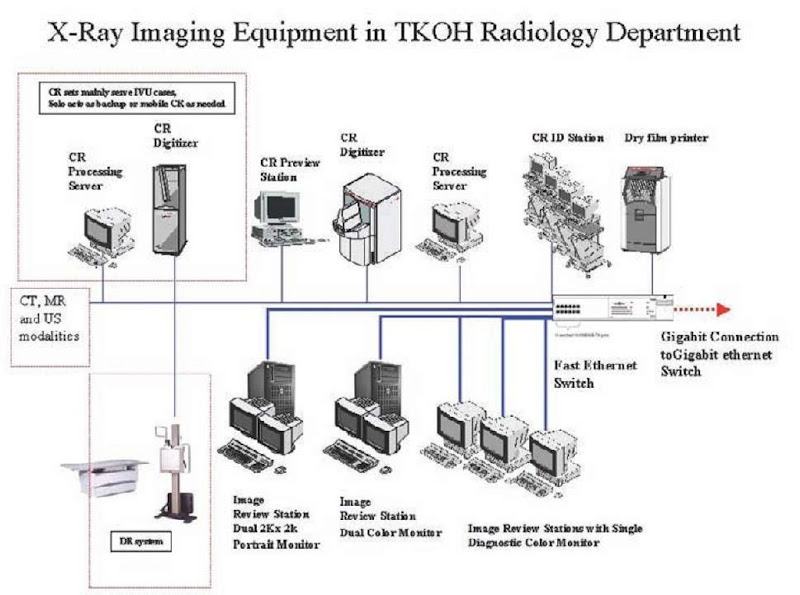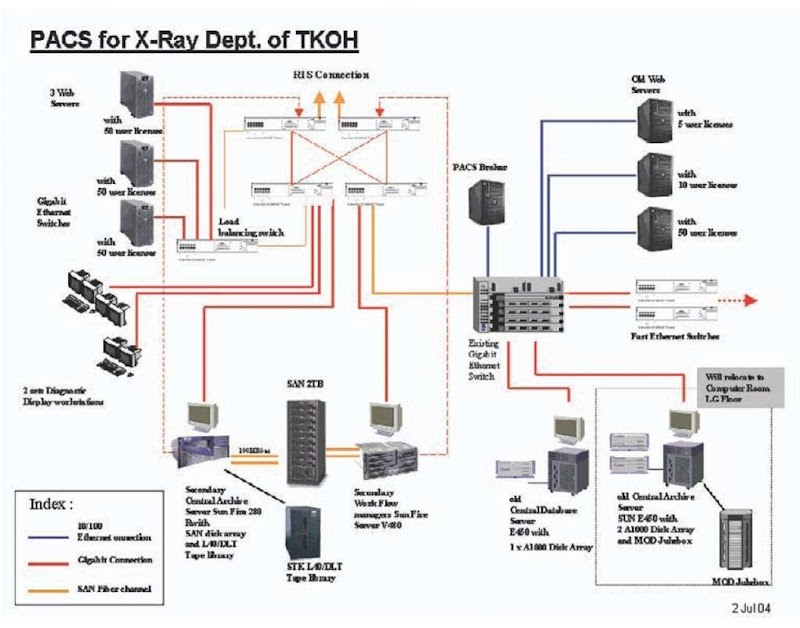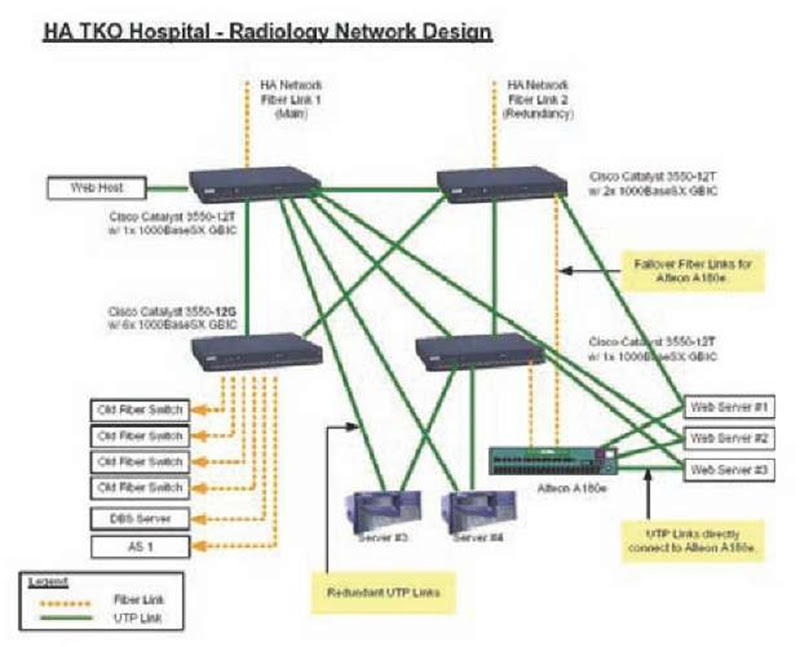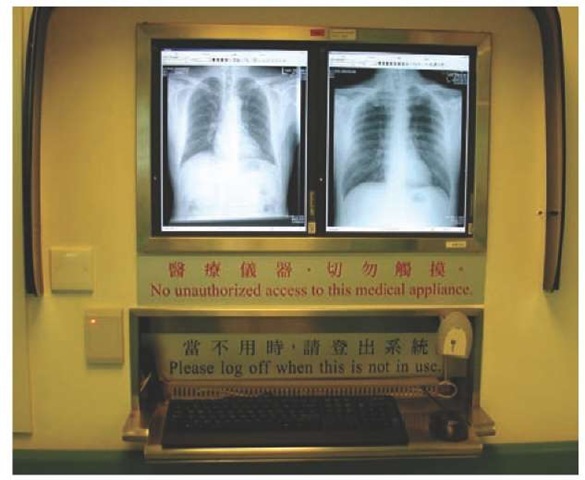Introduction
Radiology is the branch of medicine that deals with the diagnostic and therapeutic applications of radiation. It is often used in X-rays in the diagnosis and treatment of a disease. Filmless radiology is a method of digitizing traditional films into electronic files that can be viewed and saved on a computer. This technology generates clearer and easier-to-read images, allowing the patient the chance of a faster evaluation and diagnosis. The time saved may prove to be a crucial element in the patient’s treatment process. With filmless radiology, images taken from various medical sources can be manipulated to enhance resolution, increasing the clarity of the image. Images can also be transferred internally within departments and externally to other locations such as the office of the patient’s doctor. This is made possible through the picture-archiving and communication system (PACS; Dreyer, Mehta, & Thrall, 2001), which electrsonically captures, transmits, displays, and saves images into digital archives for use at any given time. The PACS functions as a state-of-the-art repository for long-term archiving of digital images, and includes the backup and bandwidth to safeguard uninterrupted network availability. The objective of the picture-archiving and scom-munications system is to improve the speed and quality of clinical care by streamlining radiological service and consultation. With instant access to images from virtually anywhere, hospital doctors and clinicians can improve their work processes and speed up the delivery of patient care. Besides making film a thing of the past, the likely benefits would include reduced waiting times for images and reports, and the augmented ability of clinicians since they can get patient information and act upon it much more quickly. The creation of a permanent, nondegradable archive will eliminate the loss of film and so forth. Today, the growing importance of PACS on the fight against highly infectious disease is also identified.
background
PACS (Huang, 2004) started with a teleradiology project sponsored by the U.S. Army in 1983. A follow-up project was the Installation Site for Digital Imaging Network and Picture Archiving and Communication System (DIN/PACS) funded by the U.S. Army and administered by the MITRE Corporation in 1985. Two university sites were selected for the implementation—the University of Washington in Seattle and Georgetown University and George Washington University Consortium in Washington, DC—with the participation of Philips Medical Systems and AT&T. The U.S. National Cancer Institute funded one of UCLA’s first PACS-related research projects in 1985 under the title Multiple Viewing Stations for Diagnostic Radiology.
The early installations of PACS in public health-care institutions were in Baltimore Veterans Administration Medical Center (United States), Hammersmith Hospital (United Kingdom), and Samsung Medical Center (Korea). In Hong Kong, there was no PACS-related project until the establishment of Tseung Kwan O Hospital (TKOH) in 1998. The TKOH was a newly built 600-bed acute hospital with a hospital PACS installed for the provision offilmless radiological service. The design and management of the PACS for patient care will be discussed in this article. The TKOH was opened in 1999 with PACS installed. At the beginning, due to immature PACS technologies, the radiology service was operating with film printing. A major upgrade was done in 2003 for the implementation of server clustering, network resilience, liquid crystal display (LCD), smart card, and storage-area-network (SAN) technologies. This upgrade has greatly improved the reliability of the system. Since November 2003, TKOH has started filmless radiology service for the whole hospital. It has become one of the first filmless hospitals in the Greater China area (Seto, Tsang, Yung, Ching, Ng, & Ho, 2003; Tsou, Goh, Kaw, & Chee, 2003).
MAIN FOCUS OF THE ARTICLE
It certainly goes without saying that most equipment is designed for reliability, but breakdowns can still occur, especially when equipment is used in a demanding environment. A typical situation is what could be called a “single-point failure.” That is, the entire system fails if only one piece of equipment such as a network switch fails. If some of the processes that the system supports are critical or the cost of a system stop is too high, then building redundancy into the system is the way to overcome this problem. There are many different approaches, each of which uses a different kind of device, for providing a system with redundancy.
The continuous operation of a PACS in a filmless hospital for patient care is a critical task. The design of a PACS for such a system should be high speed, reliable, and user friendly (Siegel & Kolodner, 2001). The main frame of the design is avoiding the occurrence of any single point of failure in the system. This design includes many technical features. The technical features of the PACS installed in a local hospital include the archiving of various types of images, clustering of Web servers installed, redundancy provision for image distribution channels, and adoption of barcode and smart-card systems. All these features are required to be integrated for effective system performance and they are described below.
archiving of multiple image types
In order to make connections with different imaging modalities, a common international standard is important. The Digital Imaging and Communications in Medicine (DICOM) standard developed by the American College of Radiology (ACR) and the National Electrical Manufacturers’ Association (NEMA) is the most common standard used today. The DICOM standard is extremely comprehensive and adaptable. It covers the specification image format, a point-to-point connection, network requirements, and the handling of information on networks. The adoption of DICOM by other specialties that generate images (e.g., pathology, endoscopy, dentistry) is also planned.
The fact that many of the medical imaging-equipment manufacturers are global corporations has sparked considerable international interest in DICOM. The European standards organization, the Comita Europaen de Normalisation, uses DICOM as the basis for the fully compatible MEDICOM standard. In Japan, the Japanese Industry Association of Radiation Apparatus and the Medical Information Systems Development Center have adopted the portions of DICOM that pertain to the exchange of images on removable media and are considering DICOM for future versions of the Medical Image Processing Standard. The DICOM standard is now being maintained and extended by an international, multispecialty committee. Today, the DICOM standard has become a predominant standard for the communication of medical imaging devices.
web technology
The World Wide Web (WWW) began in March 1989 at CERN (CERN was originally named after its founding body, the Conseil Europeen pour la Recherche Nucleaire, that is now called the European Laboratory for Particle Physics.). CERN is a meeting place for physicists from all over the world who collaborate on complex physics, engineering, and information-handling projects. Thus, the need for the WWW system arose from the geographical dispersion of large collaborations and the fast turnover of fellows, students, and visiting scientists who had to get up to speed on projects and leave a lasting contribution before leaving.
Set off in 1989, the WWW quickly gained great popularity among Internet users. For instance, at 11:22 a.m. of April 12, 1995, the WWW server at the SEAS (School of Engineering & Applied Science) of the University of Pennsylvania responded to 128 requests in 1 minute. Between 10:00 and 11:00, it responded to 5,086 requests in 1 hour, or about 84 requests per minute. Even years after its creation, the Web is constantly maturing: In December 1994 the WWW was growing at roughly 1% a day—a doubling in a period of less than 10 weeks (Berners-Lee, 2000).
The system requirements for running a WWW server (Menasce & Almeida, 2001, 2004) are minimal, so even administrators with limited funds had a chance to become information providers. Because of the intuitive nature of hypertext, many inexperienced computer users were able to connect to the network. Furthermore, the simplicity of the hypertext markup language, used for creating interactive documents, has allowed many users to contribute to the expanding database of documents on the Web. Also, the nature of the World Wide Web provided a way to interconnect computers running different operating systems, and display information created in a variety of existing media formats. In short, the Web technology provides a reliable platform for the distribution of various kinds of information including medical images.
Another advantage of Web technology is its low demand on the Web client. Any computer running on a common platform such as Windows or Mac can access the Web server for image viewing just using Internet Explorer or Netscape. Any clinical user can carry out his or her duty anytime and anywhere within a hospital.
clustering of dicom web servers
The advantage of clustering computers for high availability (Piedad & Hawkings, 2000) is that if one of the computers fails, another computer in the cluster can then assume the workload of the failed computer at a prespecified time interval. Users of the system see no interruption of access. The advantages of clustering DICOM Web servers for scalability include increased application performance and the support of a greater number of users for image distribution.
There is a myth that to provide high availability (Marcus & Stern, 2003), all that is required is to cluster one or more computer-hardware solutions. To date, no hardware-only solution has been able to deliver trouble-free answers. Providing trouble-free solutions requires extensive and complex software to be written to cope with the myriad of failure modes that are possible with two or more sets of hardware.
Clustering can be implemented at different levels of the system, including hardware, operating systems, middleware, systems management, and applications. The more layers that incorporate clustering technology, the more complex the whole system is to manage. To implement a successful clustering solution, specialists in all the technologies (i.e., hardware, networking, and software) are required. The authors used the clustering of Web servers by connecting all of the Web servers using a load-balancing switch. This method has the advantage of a low server overhead and requires no computer-processor power.
RAID TECHNOLOGY
Patterson, Gibson, and Katz (1988) at the University of California, Berkeley, published a paper entitled “A Case for Redundant Arrays of Inexpensive Disks (RAID).” This paper described various types of disk arrays, referred to by the acronym RAID. The basic idea of RAID was to combine multiple small, inexpensive disk drives into an array of disk drives, which yields performance exceeding that of a single large, expensive drive (SLED). Additionally, this array of drives appears to the computer as a single logical storage unit or drive.
The mean time between failure (MTBF) of the array will be equal to the MTBF of an individual drive divided by the number of drives in the array. Because of this, the MTBF of an array of drives would be too low for many application requirements. However, disk arrays can be made fault tolerant by redundantly storing information in various ways.
Five types of array architectures, RAID-1 through RAID-5, were defined by the Berkeley paper, each providing disk fault tolerance and each offering different trade-offs in features and performance. In addition to these five redundant array architectures, it has become popular to refer to a nonredundant array of disk drives as a RAID-0 array.
In PACS, RAID technology can provide protection for the availability of the data in the server. In RAID level 5, no data is lost even during the failure of a single hard disk within a RAID group. This is essential for a patient-care information system. Extra protection can be obtained by using spare global hard disks for automatic protection of data during the malfunctioning of more than one hard disk. Today, most SANs for high capacity storage are built on RAID technology.
STORAGE AREA NETWORK
A storage area network (Marcus & Stern, 2003; Toigo & Toigo, 2003) is a high-speed, special-purpose network (or subnetwork) that interconnects different kinds of data-storage devices with associated data servers on behalf of a larger network of users. Typically, a storage-area network is part of the overall network of computing resources for an enterprise. A storage-area network is usually clustered in close proximity to other computing resources such as SUN (SUN Microsystems) servers, but it may also extend to remote locations for backup and archival storage using wide-area-network carrier technologies such as ATM (Asynchronous Transfer Mode) or Ethernet.
Storage-area networks use fiber channels (FCs) for connecting computers to shared storage devices and for interconnecting storage controllers and drives. Fiber channel is a technology for transmitting data between computer devices at data rates of up to 1 or 2 Gbps and 10 Gbps in the near future. Since fiber channel is 3 times as fast, it has begun to replace the small computer system interface (SCSI) as the transmission interface between servers and clustered storage devices. Another advantage of fiber channel is its high flexibility; devices can be as far as 10 km apart if optical fiber is used as the physical medium. Standards for fiber channel are specified by the Fiber Channel Physical and Signaling standard, and the ANSI (The American National Standards Institute) X3.230-1994, which is also ISO (International Organization for Standardization) 14165-1.
Other advanced features of a SAN are its support of disk mirroring, backup, and restoring; archival and retrieval of archived data; data migration from one storage device to another; and the sharing of data among different servers in a network. SANs can also incorporate subnetworks with network-attached storage (NAS) systems.
redundant network for image distribution
Nevertheless, all of the PACS devices still need to be connected to the network, so to maximize system reliability, a PACS network should be built with redundancy (Jones, 2000). To build up a redundant network (Marcus & Stern, 2003), two parallel gigabit-optical fibers were connected between the PACS and the hospital networks as two network segments using four Ethernet switches. The Ethernet switches were configured in such a way that one of the network segments was in active mode while the other was in standby mode. If the active network segment fails, the standby network segment will become active within less than 300 ms to allow the system to keep running continuously.
bar-code system
Recognizing that manual data collection and keyed data entry are inefficient and error prone, bar codes evolved to replace human intervention. Bar codes are simply a method of retaining data in a format or medium that is conducive to electronic data entry. In other words, it is much easier to teach a computer to recognize simple patterns of lines, spaces, and squares than it is to teach it to understand written characters or the English language. Bar codes not only improve the accuracy of entered data, but also increase the rate at which data can be entered.
A bar-code system includes printing and reading the bar-code labels. In most hospital information systems, the bar-code system has commonly been adopted as a part of the information system for accurate and fast patient-data retrieval. In PACS, bar-code labels are mostly used for patient identification and DICOM accession. They are used to retrieve records on patient examinations and studies.
smart-card system
A smart card is a card that is embedded with either a microprocessor and a memory chip or only a memory chip with nonprogrammable logic. The microprocessor card can add, delete, and otherwise manipulate information on the card, while a memory-chip card, such as prepaid phone cards, can only undertake a predefined operation. Smart cards, unlike magnetic-stripe cards, can carry all necessary functions and information on the card. Smart cards can also be classified as contact and contactless types. The contactless smart card communicates with the reader using the radio frequency (RF) method.
In PACS, a contactless smart-card system was installed for the authentication of the user. The information about the user name, log-in time, and location are stored in a remote server through a computer network.
NO-FILM POLICY
No film was printed when the patients were still under hospital care. Film was printed only when the patient was transferred to another hospital. Under the no-film policy, the chance of spreading infectious diseases through film is reduced.
EMBEDDED LCD MONITOR
To display medical images in the hospital, LCD monitors were installed on the walls in ward areas adjacent to existing light boxes. LCD displays utilize two sheets of polarizing material with a liquid crystal solution between them. An electric current passed through the liquid causes the crystals to align so that light cannot pass through them. Each crystal, therefore, is like a shutter, either allowing light to pass through or blocking the light. Monochrome LCD images usually appear as blue or dark-grey images on top of a greyish-white background. Colour LCD displays use two basic techniques for producing colour: Passive matrix is the less expensive of the two technologies. The other technology, called thin film transistor (TFT) or active matrix, produces colour images that are as sharp as traditional CRT (Cathode Ray Tube) displays, but the technology is expensive. Recent passive-matrix displays using new colour super-twist nematic (CSTN) and double-layer super-twisted nematic (DSTN) technologies produce sharp colours rivaling active-matrix displays.
Most LCD screens used are transmissive to make them easier to read. These are a type of LCD screens in which the pixels are illuminated from behind the monitor screen. Transmissive LCDs are commonly used because they offer high contrast and deep colours, and are well suited for indoor environments and low-light circumstances. However, transmissive LCDs are at a disadvantage in very bright light, such as outdoors in full sunlight, as the screen can be hard to read. In PACS, the LCD monitors were installed in pairs for the comparison of a large number of medical images. They were also configured in portrait mode for the display of chest X-ray CR (computed radiography) images.
IMPLEMENTATION
In the design of the TKOH PACS (Figure 1), all computed tomographic (CT), magnetic resonance (MR), ultrasound (US) and computed radio-graphic images were archived in image servers of the PACS (Figure 2). During the diagnosis and monitoring of patients with highly infectious diseases, CT and CR scans were commonly used for comparison. A large storage capacity for the present and previous studies was required. The capacity of the image servers designed was about 5 terabytes using 2.3-terabyte SAN technology and a DICOM compression of 2.5. The image distribution to the clinicians was through a cluster of Web servers, which provided high availability of the service. The connection between the PACS and the hospital network was through a cluster of automatic fail-over switches as shown in Figure 3. Our users can use a Web browser for X-ray-image viewing for the diagnosis or follow-up of patients. The Web-based X-ray-image viewers were set up on the computers in all wards, intensive care units, and specialist and outpatient departments to provide a filmless radiological service. The design of the computers for X-ray-image viewing in wards is shown in Figure 4. These computers were built using all the above technologies for performance and reliability.
Figure 1. X-ray imaging modalities in the TKOHPACS
Figure 2. Design of the TKOH PACS
Figure 3. Design of a PACS and hospital network interface
Figure 4. X-ray image viewer in wards
After 10 months of filmless radiological operation in TKOH, less than 1% of the cases required special X-ray film for follow-up. Basically, X-ray-image viewing through a computer network was sufficient for the radiological diagnosis and monitoring of patients. Furthermore, filmless radiology (Siegel & Kolodner, 2001) service definitely reduced the chance for spreading highly infectious diseases through health-care staff. No staff member from the radiology department became infected during the outbreak of the severe acute respiratory syndrome (SARS) in 2003. No film-loss and film-waiting times were recorded.
FUTURE TRENDS
In PACS, most of the hard disks used in the RAID are expensive fiber-channel drives. Some RAID manufacturers are designing their RAID controllers using mixed ATA (Advanced Technology Attachment) and fiber-channel drives in the same array with 100% software compatibility. This design has many benefits. It can reduce the data backup and restore from seconds to hours, keep more information online, reduce the cost of the RAID, and replace the unreliable tap devices in the future. Another advanced development of PACS was in the application of voice recognition (Dreyer et al., 2001) in radiology reporting, in which the computer system was able to automatically and instantly convert the radiologist’s verbal input into a textual diagnostic report. Hence, the efficiency of diagnostic radiologists can be further improved.
conclusion
It has been reported (Siegel & Kolodner, 2001) that filmless radiological service using PACS could be an effective means to improve the efficiency and quality of patient care. Other advantages of filmless radiological service are infection protection for health-care staff and the reduction of the spreading of disease through the distribution of films. In order to achieve the above tasks, many computer and multimedia technologies such as the Web, SAN, RAID, high availability, LCD, bar code, smart card, and voice recognition were applied. In conclusion, the applications of computer and multimedia technologies in medicine for efficient and quality health care is one of the important areas of future IT development. There is no boundary and limitation in this application. We shall see doctors learning and using computers in their offices and IT professionals developing new medical applications for health care. The only limitation we have is our imagination.
key terms
Clustering: A cluster is two or more interconnected computers that create a solution to provide higher availability, higher scalability, or both.
Computed Radiography (CR): Computed radiography is a method of capturing and converting radiographic images into a digital form. The medium for capturing the X-ray radiation passing through the patient and generated by a standard X-ray system is a phosphor plate that is placed in a standard-size cassette, replacing the regular radiographic film. The X-ray exposure forms a latent image on a phosphor plate that is then scanned (read or developed) using a laser-beam CR reader. The CR unit displays the resultant digital image on a computer-monitor screen. By the end of the short process, the phosphor plate is erased and ready for another X-ray image exposure.
Computed Tomography (CT): Computed tomography is a specialized radiology procedure that helps doctors see inside the body. CT uses X-rays and computers to create an image. The images show up as a cross-sectional image.
Digital Imaging and Communications in Medicine (DICOM): Digital Imaging and Communications in Medicine is a medical image standard developed by the American College of Radiology and the National Electrical Manufacturers’ Association.
Picture-Archiving and Communication System (PACS): A picture-archiving and communication system is a system used for managing, storing, and retrieving medical image data.
Redundant Arrays of Inexpensive Disks (RAID): RAID is a method of accessing multiple individual disks as if the array were one larger disk, spreading data access out over these multiple disks, thereby reducing the risk of losing all data if one drive fails and improving access time.
Severe Acute Respiratory Syndrome (SARS): Severe acute respiratory syndrome is a newly emerged infectious disease with moderately high transmissibility that is caused by a coronavirus.
Storage-Area Network (SAN): A storage-area network is a networked storage infrastructure (also known as a fabric) that provides the any-to-any connectivity between servers and storage devices, such as RAID disk systems and tape libraries.




